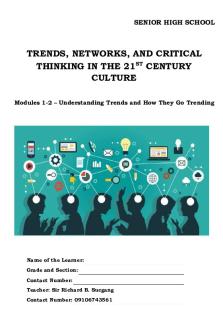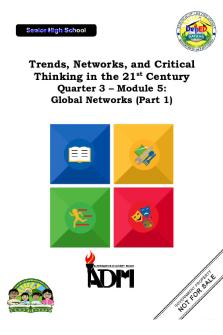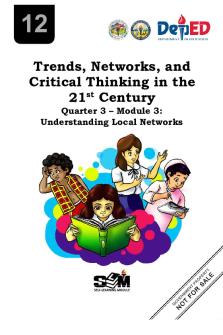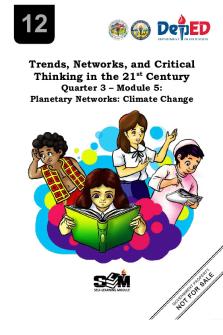TNCT Module 5-6 - TRENDS, NETWORKS, AND CRITICAL THINKING PDF

| Title | TNCT Module 5-6 - TRENDS, NETWORKS, AND CRITICAL THINKING |
|---|---|
| Course | Bachelor of Secondary Education |
| Institution | Mindanao State University |
| Pages | 19 |
| File Size | 555.7 KB |
| File Type | |
| Total Downloads | 2 |
| Total Views | 64 |
Summary
SENIOR HIGH SCHOOLTRENDS, NETWORKS, AND CRITICALTHINKING IN THE 21ST CENTURYCULTUREModules 5 – Global NetworksModule 6 – Understanding the Consequences of Personal andLocal Action to Global and Planetary Climate ChangeName of the Learner: Grade and Section: Contact Number: Teacher: Sir Richard B. Su...
Description
SENIOR HIGH SCHOOL
TRENDS, NETWORKS, AND CRITICAL THINKING IN THE 21ST CENTURY CULTURE Modules 5 – Global Networks Module 6 – Understanding the Consequences of Personal and Local Action to Global and Planetary Climate Change
Name of the Learner: Grade and Section: Contact Number: Teacher: Sir Richard B. Sucgang Contact Number: 09106743561
CONTENT STANDARDS The learner understands the components, operations, effects, and networks of globalization in his/her life PERFORMANCE STANDARDS The learner locates on a map the different geographical origins of the various components/elements of an industrial/technological/agricultural product and writes a reflection essay on the insights gathered from the exercise. The learner locates on a map the workplaces of the OFWs in their community and writes a reflection paper on the effects of labor migration to their community. KEEP IN MIND To learn and benefit from this module, follow the following steps: 1. Read the module title and the module introduction to get an idea of what the module covers. Specifically, read the first two sections of this module carefully. The first section tells you what this module is all about while the second section tells you of what you are expected to learn. 2. Never move on to the next page unless you have done what you are expected to do in the previous page. Before you start each lesson, read first the INSTRUCTIONS. 3. Work on the activities. Take note of the skills that each activity is helping you to develop. 4. Take the Post-Test after you are done with all the lessons and activities in the module. 5. Meet with your teacher. Ask him/her about any difficulty or confusion you have encountered in this module. 6. Finally, prepare and gather all your outputs and submit them to your teacher. 7. Please write all your answers of the tests, activities, exercises, and others IN YOUR MODULE. Use a separate paper IF NECESSARY.
LEARNING COMPETENCIES The learners will be able to: 1. give examples of various activities in one’s daily life that show the concrete effects of globalization (HUMSS_MCT12If-g-1); 2. explain the concrete effects of globalization to one’s daily life (HUMSS_MCT12-if-g2); 3. explain the need for collaboration and cooperation to achieve interconnectedness of people and nations (HUMSS_MCT12-if-g-4); a. shows the interconnectedness of people and nations (HUMSS_MCT12If-g-3).
1
4. discuss the different contributions of the parts to a whole and the important role of creative imagination in putting together the various parts of a whole (HUMSS_MCT12-If-g-5); a. stress the important role of the creative imagination in putting together the various parts of a whole (HUMSS_MCT12If-g-6); 5. illustrate the origin of the different components of a gadget, business enterprise, industrial/technological/agricultural product, etc. through a mind map and reflection essay (HUMSS_MCT12-If-g-7); a. writes a reflection essay on the insights generated from the map (HUMSS_MCT12If-g-8); 6. explain the effects of consumption and production patterns on climate change (HUMSS_MCT12-Ih-i-2); a. list activities (HUMSS_MCT12Ih-i- 1);
that
exemplify
care
for
the
environment
7. discuss personal contributions that can actually solve the problem of climate change (HUMSS_MCT12-Ih-i-3); and 8. make a stand on how the consequences of one’s action affect the lives of others and the environment (HUMSS_MCT12-Ih-i-4).
PRETEST Directions: Read each item carefully. Fill each blank with the correct answer. Write your answers on the blank provided. 1. is a process of interaction and integration among the people, companies, and governments of different nations, a process driven by international trade and investment and aided by information technology. 2.
is defined as work, especially hard physical work.
3. refers to social transformation or process leading to the achievement of people-centered development. 4. refers to an increasing trend toward multilateralism in an emerging transnational state apparatus, and toward the emergence of national and international nongovernmental organizations that act as watchdogs over governments. 5. refers to a body of persons sharing a common religion, culture, or language. 6. is a relatively large group of people organized under a single, usually independent government, a country.
2
7. is a collective concept that refers to increasing global linkages created through cross-border financial flows. 8. the process of working together to the same end. It is an active help from a person, organization etc. such as an orderly sharing of space and resources. 9. is the only global international organization dealing with the rules of trade between nations. The WTO has 164 members and 24 observer governments. 10. refers international capital markets.
to
an
individual
country's
linkages
to
DISCUSSION LESSON 1: GLOBAL NETWORKS Globalization As cited in the Revisitadestatica (2012), the term globalization refers to the emergence of an international network, belonging to an economic and social system. One of the earliest uses of the term "globalization", as known, was in 1930 - in a publication entitled “Towards New Education” to designate an overview of the human experience in education. Since the invention of the concept, globalization has inspired numerous definitions and has had a history going back in time to the great commercial and imperialist movements throughout Asia and the Indian Ocean since the fifteenth century. Roland Robertson, a professor of sociology at the University of Aberden, was the first person who defined globalization as "the understanding of the world and the increased perception of the world as a whole." Martin Albrow and Elizabeth King, sociologists, define globalization as "all those processes by which the peoples of the world are incorporated into a single world society. It can be linked to the local, the national and the regional. On the one hand, a connection is made between social and economic relationships and networks, organized on a local or national, on the other hand, it connects social and economic relationships and networks formed on wider scale the regional and global interactions. It is a process of interaction and integration among the people, companies, and governments of different nations. A process driven by international trade and investment and aided by information technology. This process has effects on the environment, on culture, on political systems, on economic development and prosperity, and on human physical well-being on societies around the world. For many developing nations, globalization has led to an improvement in standard of living through improved roads and transportation, improved health
3
care, and improved education due to the global expansion of corporations. However, globalization has had a negative effect on individuals who live in developed nations. Some of the factors that cause globalization are migration and labor. • Migration is a movement to another place, often of a large group of people. • Labor is defined as work, especially hard physical work. People are more willing to move between different countries today in search for work. Remittances now play a large role in transfers from developed countries to developing countries. Types of Globalization Economic Globalization is the increasing economic integration and interdependence of national, regional, and local economies across the world through an intensification of cross boarder movement of goods, services, technologies and capital. Examples: • Trans-national trades are companies that extend beyond the borders of one country example of these are Unilever and McDonalds • World Trade Organization is the only global international organization dealing with the rules of trade between nations. The WTO has 164 members and 24 observer governments. Social Globalization is a social transformation or process leading to the achievement of people-centered development. Human-centered development concept is offered as an alternative strategy to bring about a more equity development outcome. Examples: • UN General Assembly • Partnership of International Development Programs • Social Integration, Gender Equity and access to Social Services • HIV/AIDS Awareness Political Globalization refers to an increasing trend toward multilateralism in an emerging transnational state apparatus and the emergence of national and international non-governmental organizations that act as watchdogs over governments. The government has four distinct roles in addressing sustainability concerns. These roles are as follows: 1. Policy development 2. Regulation 3. Facilitation 4. Internal sustainability management
4
Financial Globalization is a collective concept that refers to increasing global linkages created through cross-border financial flows. Financial integration refers to an individual country's linkages to international capital markets. Technological Globalization is accelerated in large part by technological transmission, the spread of technology across borders. Although the Philippines is not the world's least technologically advanced country, it is far from leading. It ranks 83rd out of 138 countries in terms of technological readiness, according to the Department of Science and Technology (DOST). Ecological Globalization occurs when ecosystems are constantly exchanging materials through the movement of air in the atmosphere, the flow of water in rivers and the migration of animals across the landscape. The world is also becoming highly interconnected through the movement of people and the transport of goods locally to globally (EurekAlert.com). Geographical Globalization is defined as the set of processes (economic, social, cultural, technological, and institutional that contributes to the relationship between societies and individuals around the world. It is a progressive process by which exchanges and flows between different parts of the world are intensified.
5
Interconnections of People and Nations Globalization leads to interconnectedness of people and nations, where people refer to a group of people with commonality, such as religion, culture and language who lives in a specific area, while nation refers to a larger group of people organized in a specific place, which embodied an independent government of its country where they can decide on their own. Considering the new normal education, how can we enroll in our online educational programs in school from anywhere in the Philippines without the different platforms and access new information on virtual topics? Collaboration means to work together with others to achieve a common goal. Unconditionally sharing everything and helping each other while mutually working together in cohesive “collective” in unusual roles embracing talents of each person to synergize or invent something new in a way that: a. benefits all the groups, b. serves the whole team’s goal, and c. may result to creative innovation. Cooperation is the process of working together to the same end. It is an active help from a person, organization etc. such as an orderly sharing of space and resources. Cooperation means conditionally sharing information and resources while functioning together within an independent “connective” in typical roles with workloads accepted as unequal to change something in a way that: a. benefits some individuals in a group, b. meets their personal needs, and c. may result in disrupted innovation.
6
ACTIVITY 1. PICTURE ANALYSIS Directions: Examine the picture below and answer the following questions.
1. What does the picture symbolizes?
2. What can you say about the picture in terms of interconnectedness of people and nation?
7
3. Does cooperation and collaboration important in the scenario given in the picture? Why or why not?
4. As a Senior High School student, give three (3) activities in your daily life during this pandemic that show cooperation and collaboration that have an impact on globalization.
ASSESSMENT A. Directions: Read and analyze each statement. Write TRUE if the statement is correct and FALSE if it is incorrect. Write your answer on the space provided before the number. _________1. Ecological globalization is the increasing economic integration and interdependence of national, regional, and local economies across the world through an intensification of cross boarder movement of goods, services, technologies and capital. _________2. Roland Robertson was the first person who defined globalization as "the understanding of the world and the increased perception of the world as a whole." _________3. Cooperation is defined as working together with others to achieve a common goal. _________4. Country refers to a large group of people organized in a specific place, which embodied an independent government where they can decide on their own.
8
_________5. Technologies are introduced to make a narrower product more efficiently. _________6. Globalization creates opportunities for countries to connect to other countries for larger markets. _________7. Economics are constantly exchanging materials through the movement of air in the atmosphere, the flow of water in rivers and the migration of animals across the landscape. _________8. Geographical globalization is defined as the set of processes that contributes to the relationship between societies and individuals around the world. _________9. The world is becoming highly interconnected through the movement of people and the transport of goods locally to globally. _________10. Globalization leads to more access to capital flows, technology, human capital, cheaper imports, and larger export markets. B. Directions: Identify if the statement refers to cooperation or collaboration. Write the word COOP for cooperation and COLLAB for collaboration. Write your answer on the space provided before the number. ___________1. Work together with others to achieve a common goal ___________2. Conditionally sharing information and resources while functioning together within an independent “connective” in typical roles with workloads accepted as unequal ___________3. Unconditionally sharing everything ___________4. Helping each other while mutually working together in cohesive “collective” in unusual roles embracing talents of each person ___________5. Benefits all of the groups ___________6. Serves the whole team’s goal ___________7. May result in co-creative innovation ___________8. Benefits some individuals in a group ___________9. Meets their personal needs ___________10. May result in disrupted innovation...
Similar Free PDFs
Popular Institutions
- Tinajero National High School - Annex
- Politeknik Caltex Riau
- Yokohama City University
- SGT University
- University of Al-Qadisiyah
- Divine Word College of Vigan
- Techniek College Rotterdam
- Universidade de Santiago
- Universiti Teknologi MARA Cawangan Johor Kampus Pasir Gudang
- Poltekkes Kemenkes Yogyakarta
- Baguio City National High School
- Colegio san marcos
- preparatoria uno
- Centro de Bachillerato Tecnológico Industrial y de Servicios No. 107
- Dalian Maritime University
- Quang Trung Secondary School
- Colegio Tecnológico en Informática
- Corporación Regional de Educación Superior
- Grupo CEDVA
- Dar Al Uloom University
- Centro de Estudios Preuniversitarios de la Universidad Nacional de Ingeniería
- 上智大学
- Aakash International School, Nuna Majara
- San Felipe Neri Catholic School
- Kang Chiao International School - New Taipei City
- Misamis Occidental National High School
- Institución Educativa Escuela Normal Juan Ladrilleros
- Kolehiyo ng Pantukan
- Batanes State College
- Instituto Continental
- Sekolah Menengah Kejuruan Kesehatan Kaltara (Tarakan)
- Colegio de La Inmaculada Concepcion - Cebu







